Removal of chromium (VI) ions from aqueous solutions
DOI:
https://doi.org/10.15587/2706-5448.2021.242811Keywords:
chromium (VI) ions, flotoextraction wastewater treatment, hexadecylpyridinium chloride, butyl alcoholAbstract
The object of the research is the flotoextraction of chromium (VI) ions from model and real waste waters. Hexavalent chromium compounds pose a serious hazard to surface and ground waters and can have mutagenic and carcinogenic effects on living organisms. The study of the process of flotoextraction as a method of purifying waste water from heavy metals using the example of chromium (VI) ions is an important task. The paper considers flotoextraction of chromium (VI) ions using a cationic surfactant – hexadecylpyridinium chloride and butyl alcohol as the organic phase. The dependences of the process efficiency on the presence of a cationic surfactant, the flotoextraction time, the type of organic extractant, the nature of the collector and the surfactant: Cr molar ratio, the initial concentration of pollutants, and the pH of the initial solution were obtained. Certain rational conditions for flotation allow removing 98–99.6 % of pollutants. The method was tested on real wastewater.
The importance of this study is emphasized by the fact that flotoextraction has a number of features and advantages. In particular, the possibility of multiple concentration of pollutant ions in small volumes of an organic solvent and the possibility of its further regeneration. In this case, a much smaller amount of an organic solvent is used and the process is not limited by the distribution constant (compared to the extraction method). Flotoextraction is also characterized by the absence of foam (compared to the flotation method) and the absence of large amounts of wet sludge (compared to the reagent method). The proposed method provides a sufficient level of chromium ions removal from wastewater, and can also be used in systems for local wastewater treatment with the subsequent return of water to the technological process. This will ensure a reduction in costs for the consumption of water resources, discharge of wastewater into water bodies, and also limit the ingress of harmful substances into the environment.
References
- Fenti, A., Chianese, S., Iovino, P., Musmarra, D., Salvestrini, S. (2020). Cr(VI) Sorption from Aqueous Solution: A Review. Applied Sciences, 10 (18), 6477. doi: https://doi.org/10.3390/app10186477
- Gupta, S., Babu, B. V. (2009). Removal of toxic metal Cr(VI) from aqueous solutions using sawdust as adsorbent: Equilibrium, kinetics and regeneration studies. Chemical Engineering Journal, 150 (2–3), 352–365. doi: https://doi.org/10.1016/j.cej.2009.01.013
- Cavaco, S. A., Fernandes, S., Quina, M. M., Ferreira, L. M. (2007). Removal of chromium from electroplating industry effluents by ion exchange resins. Journal of Hazardous Materials, 144 (3), 634–638. doi: https://doi.org/10.1016/j.jhazmat.2007.01.087
- Bhatti, M. S., Reddy, A. S., Thukral, A. K. (2009). Electrocoagulation removal of Cr(VI) from simulated wastewater using response surface methodology. Journal of Hazardous Materials, 172, (2–3), 839–846. doi: https://doi.org/10.1016/j.jhazmat.2009.07.072
- Lu, Y., Zhu, X. (2001). Solvent Sublation: Theory and Application. Separation and Purification Methods, 30 (2), 157–189. doi: https://doi.org/10.1081/spm-100108158
- Bi, P., Dong, H., Dong, J. (2010). The recent progress of solvent sublation. Journal of Chromatography A, 1217 (16), 2716–2725. doi: https://doi.org/10.1016/j.chroma.2009.11.020
- Walkowiak, W. (2007). Ion flotation and solvent sublation of cobalt cyanide complexes. Journal of Chemical Technology and Biotechnology, 30 (1), 611–619. doi: https://doi.org/10.1002/jctb.503300180
- Lu, Y. J., Liu, J. H., Xiong, Y., Zhu, X. H. (2003). Study of a mathematical model of metal ion complexes in solvent sublation. Journal of Colloid and Interface Science, 263 (1), 261–269. doi: https://doi.org/10.1016/s0021-9797(03)00192-9
- Obushenko, T. I., Astrelin, I. M., Tolstopalova, N. M., Varbanets, M. A., Kondratenko, T. A. (2008). Wastewater treatment from toxic metals by flotoextraction. Journal of Water Chemistry and Technology, 30 (4), 241–245. doi: https://doi.org/10.3103/s1063455x08040073
- Astrelin, I. M., Obushenko, T. I., Tolstopalova, N. M., Tarhonska, O. O. (2013). Teoretychni zasady ta praktychne zastosuvannia flotoekstraktsii: ohliad. Voda i vodoochysni tekhnolohii, 3, 3–23.
- Nabyvanets, B. Y., Sukhan, V. V., Kalabina, L. V. (1996). Analitychna khimiia pryrodnoho seredovyshcha. Kyiv: Lybid, 304.
Downloads
Published
How to Cite
Issue
Section
License
Copyright (c) 2021 Tetiana Obushenko, Nataliia Tolstopalova, Mariia Chyrieva

This work is licensed under a Creative Commons Attribution 4.0 International License.
The consolidation and conditions for the transfer of copyright (identification of authorship) is carried out in the License Agreement. In particular, the authors reserve the right to the authorship of their manuscript and transfer the first publication of this work to the journal under the terms of the Creative Commons CC BY license. At the same time, they have the right to conclude on their own additional agreements concerning the non-exclusive distribution of the work in the form in which it was published by this journal, but provided that the link to the first publication of the article in this journal is preserved.







